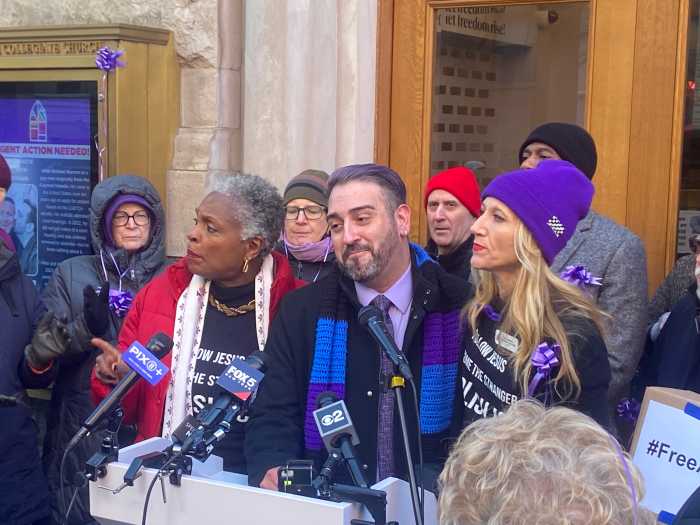Carroll Gardens is the latest community that wants to restrict the size
of “ugly” new buildings.
Coming on the heels of “downzoning” legislation in several neighboring
areas, the Carroll Garden Neighborhood Association this week called for
a 50-foot cap on the height of new residential development — the
height of a typical five-story residence.
“There is nothing we can do about the new ugly buildings that are
going up,” said Gardens homeowner Mary Mattner. “Tighter zoning
rules would give us a tool in the fight.”
Proponents of new height restrictions point to an ultramodern, six-story
condominium at 11 Second Place as an example of the kind of out-of-scale
development that is currently permitted by law. Residents of the mostly
low-rise neighborhood near the building, which is at the corner of Henry
Street, call it “the glass thumb” — as in sore thumb.
Carroll Gardens stretches from Douglass to Huntington streets and from
Columbia to Smith streets. Preservationists say the small Carroll Gardens
Historic district — between Smith and Hoyt streets and from Second
to Union streets — is powerless to protect dozens of 19th-century
Italianate rowhouses on the surrounding blocks.
“No one wants to freeze growth, but when you are dealing with a neighborhood
that is largely two- or three-story buildings, you need some kind of height
cap to preserve integrity,” said Simeon Bankoff, executive director
of the Historic Districts Council.
The irony is that many people are lining up to support new development.
The first five condos at 11 Second Place sold on their first day on the
market; the last few sold quickly this fall.
“It sold great, and as far as we can see, the demand for that caliber
of housing is very real,” said real estate broker Lisa Marshall.
“We are seeing a lot of interest.”
At 151 Carroll St., scaffolding climbs 58-feet in the air as a developer
replaces a one-story parking garage with a six-story condominium. At Smith
and Union streets, a parking garage is also undergoing conversion into
condominiums.
A rezoning would limit the supply of new housing units — which, if
the laws of economics aren’t overturned — would mean higher
prices for existing housing. But members of the Carroll Gardens Association
argue that new limits are the only way to keep the intimate feel of a
place studded with steeples and green lawns.
Downzonings have become a popular anti-development tool for residents
and elected officials in Brooklyn. Since 2002, the city has approved height
limitations in Park Slope, Bay Ridge and a section of northern Sunset
Park called Green-Wood Heights.
And within the next few weeks, the city will vote on downzonings for Homecrest,
Sheepshead Bay and Midwood.
Such a plan is also in the works for Fort Greene, where a 13-story condo
was built on a block of four-story brownstones.
“That building on Carlton Avenue is just one small piece of what
is happening,” said President of the Fort Greene Association Phillip
Kellogg.
“There is Downtown Brooklyn on one side, Atlantic Yards, if that
happens, the development around BAM. We have to preserve the scale of
the neighborhood,” he explained.
The Fort Greene Association expects to meet with the Department of City
Planning in the next two weeks.
Zoning experts Aaron Brashear and Mic Holwin said Tuesday that no “downzoning”
comes without a corollary “upzoning.”
“City Planning will never approve a change that doesn’t create
some places for developers to build,” said Holwin.
Holwin and Brashear know such battles from the inside. They worked out
the downzoning of Green-Wood Heights that also opened up Fourth Avenue
to high-rise residential development.
Included in that rezoning was an incentive program that allowed developers
to build higher than what was allowed under the code if they set aside
a certain percentage of affordable units.
“There are some folks who just want to preserve scale, but that doesn’t
account for the need for housing,” said City Councilman Bill DeBlasio
(D-Carroll Gardens).
“If we don’t build more affordable units in our neighborhoods,
we are going to become a city of the upper-middle class.” .
























